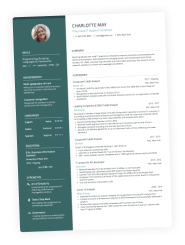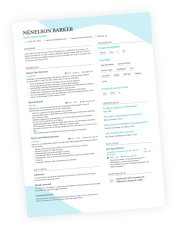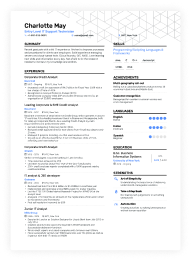Certifications aren’t just credentials. They’re powerful tools for demonstrating expertise and dedication and add to the narrative of your professional journey.
Presenting your certifications well can significantly boost your CV’s impact, opening doors to new opportunities and career advancements. However, adding low-quality, out-of-date, or irrelevant certifications can raise flags for a recruiter, potentially sinking your chance of landing a job.
No worries. We’ve written this article to show how you can include certifications on your CV for the best chance on your next job application.
In this article, we:
- Explain the various types of certifications and why you would include them on your CV
- Describe some of the jobs that commonly require certifications
- Show you how to choose the right certifications for your target job
- Clear up how to include expired or ongoing certifications
- And explain where and how to place certifications on your CV, with 9 examples to help!
What are certificates, and why do they matter on your CV?
Certificates or certifications – for our purposes, these terms are interchangeable - serve as tangible proof of specialised skills and knowledge, enhancing and adding value to your CV. They’re awarded by recognised bodies or institutions, hold independent significance, and indicate a person’s commitment to learning and expertise in their field.
Including them on your CV enhances your credibility and positions you as a standout contender in a competitive job market. And that’s what you need to grab a recruiter's attention before you risk your CV being cast onto the discard pile.
Types of certificates
There are several different types of certifications that can vary by type, industry, and role. Some of the most common include:
Industry-specific certifications
This type of certificate is tailored to a particular industry, such as IT certifications (e.g.,CompTIA,Cisco), project management certifications (e.g.,PRINCE2), or health and safety certifications (e.g.,NEBOSH).
Professional development certificates
These certifications contribute to personal and professional growth,including leadership and management certificates, communication skills certificates, or specialised workshops.
Language proficiency certificates
Certificates verifying proficiency in languages, such as theInternational English Language Testing System (IELTS) or language-specific certifications like the DELE for Spanish.
Technology and software certifications
These are certifications showcasing proficiency in specific software or technologies, such asMicrosoft Office Specialist (MOS) certifications orAdobe Certified Associate (ACA) certifications.
Project-based certificates
You earn these certifications by completing specific projects or initiatives, demonstrating hands-on experience, and applying practical skills. These include Google IT Support Professional Certificate, Scrum Alliance Certified ScrumMaster (CSM), and PMP (Project Management Professional) Certification, among others.
Jobs that require certificates
While not every job requires certification, some do, while in others they aren’t necessary but could give you a leg up on other candidates. They’re badges of expertise, giving you a competitive edge in the job market.
You’ll likely need and certainly should try to certify in the industries below if you’re looking for a job in these fields.
Information technology (IT)
Network administrators, cybersecurity analysts, and software developers often need industry-specific certifications to validate technical skills.
Project management
Project managers and team leaders benefit from certifications, like PRINCE2 or Project Management Professional (PMP), that showcase their expertise in efficient project delivery.
Health and safety professions
Jobs in health and safety, like occupational health and safety officers or site supervisors, often need certifications like NEBOSH for regulatory compliance.
Language-dependent roles
Certificates in language proficiency are invaluable where multilingual skills are essential. Think roles in translation, international relations, or customer service.
Creative and design fields
Graphic designers, web developers, or digital marketers can showcase Adobe Certified Professional (ACP) or other software-specific certifications to demonstrate technical proficiency.
Certifications vs. degrees
Certifications and traditional degrees play distinct but complementary roles in shaping a well-rounded skill set. By recognising and leveraging the complementary nature of these educational pursuits, you position yourself as a dynamic and well-prepared candidate
Here's how these two educational avenues can work in tandem to enhance your credentials:
Certifications as targeted expertise
Certifications serve as focused, industry-specific endorsements that validate your expertise in particular skills or technologies.
A degree provides a broader understanding of a field, and certifications drill down into specific areas, offering a concentrated and practical grasp of relevant concepts.
Immediate applicability of certifications
Unlike traditional degrees that may take years to complete, certifications often have shorter durations, allowing for quicker acquisition of specialised knowledge. This immediacy translates to quickly applying acquired skills in real-world scenarios, instantly boosting your professional qualifications.
Degree enhancement
Integrating certifications along your academic journey complements the theoretical foundation laid by traditional degrees with hands-on, industry-relevant proficiency. For instance, coupling a degree in business with a project management certification demonstrates a well-rounded skill set, showcasing theoretical knowledge and practical application.
Staying current
In rapidly evolving industries, certifications are a continuous learning tool, helping you stay abreast of the latest trends and technologies. This adaptability is crucial as industries increasingly value candidates who have stayed current in their field’s ongoing advancements.
Choosing the right certificates and achievements
A well-curated selection of certifications on your CV can set you apart. Couple strategic choices aligned with your industry and career goals, with certificates from recognised bodies, to create a compelling narrative of your professional readiness.
Follow this structured guide to navigate this process:
Identify industry-relevance
Start by researching certifications that are valued in your industry. Certain certificates hold more weight than others, Whether in IT, marketing, or carpentry.
Online platforms like LinkedIn or industry forums can offer insights into what certifications are trending or in-demand. You can also turn to people in your network with insights in these fields.
Consider your career goal
Tailor your certifications to the job and your career goals. Aligning your certificates with your aspirations showcases a strategic approach to your professional development.
For example, project management certifications might be helpful if you're eyeing a managerial role. Or, for a technical role, focus on certifications related to specific technologies or software.
Check employer preferences
Explore job descriptions for positions you're interested in since employers often specify preferred certifications. By aligning your choices with their expectations, you demonstrate that you've proactively acquired the relevant skills for your target role.
Research and choose recognised certification bodies
Not all certifications are created equal. Investigate the credibility of the certification body. Consider industry recognition, rigorous examination processes, and the body's standing within professional communities.
Don’t waste time or money on low-quality, fly-by-night websites or other certification institutions. They won’t impress at best, and for people in the know, they’ll likely reflect poorly on your work ethic.
Emphasise certificates from reputable and recognised bodies in your target industry. They’ll add credibility to your CV, reassuring employers of the quality of your training.
Highlight achievements on your CV
Once you’re certified, integrate these achievements into your CV. Create a dedicated section for certifications, showcasing the relevant details.
This means including the certification name, issuing body, and completion date to ensure potential employers quickly spot your qualifications. Keep reading; we’ve got more on how to do this below.
Highlight skills gained
If all you do is list your certifications, you’re missing out on an opportunity to sell yourself to potential employers. Transform your CV into a dynamic document that lists certifications and vividly portrays the skills you derived from them.
You can integrate these skills using impactful language and align them with job requirements to create a compelling narrative of your capabilities. Apply any or all of the options below to boost the impact certifications have on your CV.
Tailor skills to job requirements
Align your skills with specific job requirements, which you’re likely to find in the job posting or through research on similar positions in the industry. For example, if a job posting emphasises project management skills and you hold a PMP certification, highlight instances where your expertise positively impacted previous roles.
Integrate skills gained
While a dedicated skills section is an important part of many CV formats, you can include skills you learned in a brief bullet point entry below the standard certification info.
Use action verbs and quantify achievements.
When describing your skills, use dynamic action verbs to convey them. Also, quantify the impact you had applying those skills where you can.
For example, instead of a bland entry like:
- Learned continuous improvement methods.
Say
- Applied advanced continuous improvement to streamline processes, resulting in a 20% efficiency improvement.
Highlight soft skills
Certifications are often evidence of having mastered a certain level of technical, or hardskills. But they also often impart valuable softskills.
If your certification involves teamwork or leadership components, emphasise these aspects. For instance,
- Led cross-departmental teams to successfully implement innovative solutions, reducing manufacturing errors by 13%.
Demonstrate problem-solving
Employers value individuals who can navigate challenges, so showcase the problem-solving abilities you acquired through certifications. Describe situations where your certification-enabled problem-solving contributed to project success or issue resolution.
Show continuous learning
Emphasise that certifications represent an ongoing commitment to learning. Communicate that you continually update your skill set to stay abreast of industry trends, signalling to employers that you're adaptable and invested in professional growth.
Keeping certifications updated
Maintaining an up-to-date CV certification section is pivotal for showcasing your current and ongoing professional development. While we generally suggest excluding expired certifications, in some cases, you might choose to include them with explanations.
Highlighting your completed and ongoing pursuits illustrates your dedication and positions you as a proactive candidate in staying at the forefront of industry advancements. Follow this simple advice on when and how to include expired certifications and ongoing professional development.
Highlight relevance and currency
Hiring managers value up-to-date skills that align with industry standards. Ensure that your certifications are relevant to your current career goals and the evolving demands of your industry.
Exclude expired certifications
Generally, it's advisable to exclude expired certifications from your CV. However, if an expired certification remains highly relevant or holds historical significance, briefly mention it in a separate section.
Focus on your current certifications, demonstrating your commitment to adapting to industry changes.
Explain expired certifications
If you choose to include an expired certification, offer a brief explanation and mention any ongoing efforts to update or renew the certification. This communicates transparency and a proactive approach to skill maintenance.
Specify expected completion dates
When listing certifications in progress, mention the expected completion dates. This provides a timeline for potential employers, indicating your dedication to furthering your skills and knowledge.
For example:
- NEBOSH Certification, Ongoing, Expected completion: May 2025
Detail industry relevance
Sometimes, you may want to describe how your certifications align with industry trends and advancements. Maybe you’re including relevant certifications from another field or where they’re not strictly required in an industry, or you’re not sure the person reviewing your CV will recognise the relevance.
Connecting the dots between your pursuits and the skills demanded by your target roles reinforces your relevance and value to prospective employers.
Regularly update your CV
Treat your CV as a dynamic document. Regularly review and update your certification section as you complete courses or earn new certifications to ensure it accurately reflects your current skill set and professional growth.
Adding certification descriptions
While it's not required to include detailed certification descriptions on your CV, providing a brief context or achievement can be beneficial. Including them offers additional insight into the practical application of your skills, especially if the certification name alone might not fully convey its relevance to the job.
Here are some considerations when deciding whether to include certification descriptions on your CV:
Relevance to the job
A brief description can reinforce the significance and value of a certification that directly aligns with the job you're applying for but isn’t a regulated condition of employment. This is particularly useful if the certification is not universally understood.
Highlighting achievements
Including a short description allows you to highlight specific achievements or projects related to the certification. This provides tangible evidence of how you've applied the knowledge gained from the certification in real-world scenarios.
Adding value
A detailed explanation may be unnecessary if the certification is well-known and widely understood in your target industry. However, a brief description can add value if the certification is less common or if you've achieved notable success during the certification process.
Clarity for non-technical readers
If your CV may be reviewed by individuals unfamiliar with your industry's certifications, a concise explanation can help ensure clarity. This is especially relevant if you're transitioning between sectors.
Space considerations
Keep descriptions concise to maintain a clean and readable CV. Use short, impactful sentences to convey the relevance and impact of each certification.
Here's an example of how you might include a description for a certification:
- Project Management Professional (PMP), Project Management Institute, April 2021
- Applied advanced PMP methods across multiple teams, resulting in a 12% reduction in project timelines.
Ultimately, the decision to include descriptions depends on the specific certifications, your career goals, and the expectations of your industry. It's about balancing providing enough information to showcase your expertise and keeping your CV concise and focused.
Strategic placement on your CV
When it comes to showcasing certifications on your CV, placement should be strategic. You can place your certifications in a dedicated section or include them in your education section.
The optimal placement depends on your career stage, the relevance of certifications to the role, and your personal preference. Choose a format that enhances the overall flow of your CV, ensuring that your certifications get the attention they deserve from potential employers.
Consider these factors to maximise the impact of your CV certifications section:
Separate section
This approach allows your certifications to stand out distinctly, emphasising their importance in your professional profile. Recruiters often scan CVs quickly; a separate section ensures that your certifications catch their attention promptly.
To do this, create a dedicated "Certifications" section following your "Education" and "Professional Experience" sections.
Integration within education
This approach emphasises the educational aspect of certifications, positioning them as integral to your academic and professional development. Integrating certifications within education provides a seamless narrative of your academic and certification achievements in one cohesive section.
If you opt to format your CV in this way, include certifications within the "Education" section of your CV as a subsection or alongside your degree information.
Consider your career level
Entry-level: If you're starting your career, or if this CV is for your first job, placing certifications near the top of your CV (following your education) can highlight your specialised skills and enhance your marketability.
Experienced: If you have significant work experience, a separate section might be more effective in ensuring that your diverse skill set, including certifications, doesn't get overshadowed.
Prioritise relevance
Tailor to job requirements: If certain certifications are particularly relevant to a specific job application, consider featuring them prominently on the first page of your CV.
Highlight key certifications: If you have a certification that significantly enhances your candidacy, place it in a prominent position to quickly catch the recruiter's eye.
Formatting for impact
A well-organised CV with a tidy format enhances readability and communicates professionalism and attention to detail. But, organising and listing certifications on your CV requires a strategic approach to ensure clarity and highlight their relevance.
Follow these simple steps to effectively list certifications:
Prioritise clarity and readability
A cluttered CV can be overwhelming for employers. Prioritise clarity by using a clean, professional font and maintaining consistent formatting throughout.
Aim for a visually appealing layout that guides the reader effortlessly through your qualifications. Ensuring sufficient whitespace is a crucial aspect of good CV design, so consider what you include.
Create a distinct certification section
Dedicate a specific section to your certifications to give them the attention they deserve. This can be placed after your education or within a skills section, depending on your preference and the relevance of certifications to your targeted roles, or as we mentioned, as a subsection within it.
Use a clear heading
Add a clear heading or subheading for the certification section, such as "Certifications" or "Professional Development” to ensure employers can quickly locate and focus on your qualifications.
List certifications in reverse chronological order
Arrange your certifications in reverse chronological order, starting with the most recent. This provides a natural flow and highlights your most current and relevant qualifications.
Use bullet points
Using bullet points will help you present information succinctly and improve readability while maximising whitespace.
Include key details
For each certification, provide key details in a consistent format. These include:
- Certification name, Issuing body, Date of completion
And will look something like this:
- Certified ScrumMaster, Scrum Alliance, March 2025
Consider adding a brief description
Optionally, include a brief description or achievement related to each certification. This adds context to your qualifications.
For instance:
- Certified ScrumMaster, Scrum Alliance, March 2025
- Led successful implementation of Agile methodologies, resulting in a 30% increase in project efficiency
Certification dates
You should also consider Applicant Tracking Systems (ATS) when adding the dates in your certification section. These systems scan CVs for specific keywords related to the job, skills, and qualifications needed, and are increasingly used by employers to efficiently evaluate applications.
To ensure your CV is ATS-friendly, use a standard “Month Year" format and avoid using unique date formats or abbreviations when listing your certifications.
Maintain consistent formatting across sections
Ensure that your certification section aligns with the overall formatting of your CV. Consistency in font, spacing, and alignment contributes to a polished and professional appearance.
Examples
While there’s a lot to think about when adding certifications to your CV, we’ve broken it down into bite-sized chunks to make it easier. Here are nine examples of certification entries across different industries to show you how to put our advice together:
Information Technology (IT):
- CompTIA A+, CompTIA, August 2020
Digital marketing
- Digital Marketing Institute Professional Certification, Digital Marketing Institute, May 2022
- Validates digital marketing strategies, SEO, social media, and analytics expertise.
Project Management
- PRINCE2 Foundation, AXELOS, June 2025
- Successfully implemented PMP principles, resulting in a 5% reduction in project timelines and 3% cost savings.
Human Resources (HR)
- CIPD Level 3 Foundation Certificate in HR Practice, CIPD, August 2019
- Provides a solid foundation in HR practices, employment law, and organisational development.
Finance and accounting
- Association of Chartered Certified Accountants, ACCA, March 2020
- Implemented ACCA principles to enhance financial reporting accuracy, leading to a 10% improvement in audit efficiency and ensuring compliance with regulatory standards.
Healthcare
- Advanced Life Support (ALS), Resuscitation Council UK, Expiry: November 2026
- Demonstrates proficiency in advanced life support techniques for healthcare professionals.
Graphic design
- Graphic Design and Illustration Using Adobe Illustrator, Adobe, May 2025
- Applied advanced Illustrator techniques leading to a 25% increase in client satisfaction year over year.
Construction and engineering
- Construction Skills Certification Scheme Card, CSCS, Expiry: May 2025
- Essential certification in the construction industry, verifying health and safety competence.
Teaching and education
- Postgraduate Certificate in Education, University of Bristol, December 2025
- Recognised teaching qualification covering pedagogy and classroom management.
Takeaways
- Certifications are only required for some jobs, but can be impressive in many roles.
- They provide evidence of practical expertise.
- Select relevant certifications specific to your target role.
- It’s advisable to omit outdated certifications and avoid low-quality ones.
- Place certifications either in a separate section or within the education section on your CV.
- Adding a description of the skills or achievements related to the certification can be helpful.



